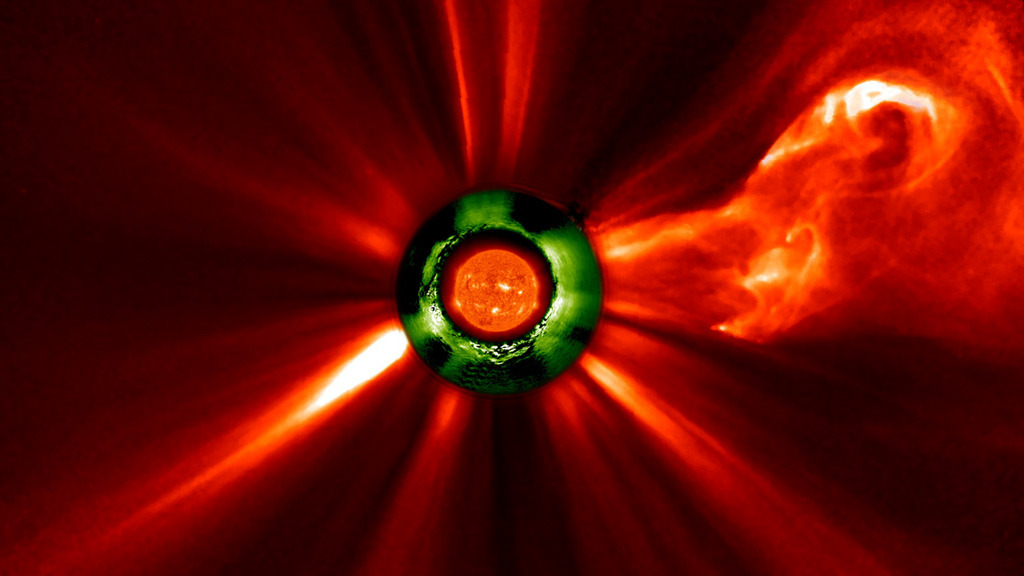Stereo Captures Eruption and CME
On May 1, 2013, NASA's Solar Terrestrial Relations Observatory Ahead (STEREO-A) satellite along with its twin STEREO Behind (STEREO-B), observed an active region (right) of the sun erupt. This eruption, called a coronal mass ejection, or CME, sent plasma streaming out through the solar system. STEREO has an extreme ultraviolet camera similar to the Solar Dynamics Observatory (SDO) satellite, but it also has coronagraph telescopes like the European Space Agency/NASA Solar and Heliospheric Observatory (SOHO) where the bright sun is blocked by a disk so it does not overpower the fainter solar atmosphere. As a result, using its two inner coronagraphs, STEREO was able to track the CME from the solar surface out to 6.3 million miles.
Prominence eruption and CME captured by STEREO on May 1, 2013.
For More Information
Credits
Please give credit for this item to:
NASA's Goddard Space Flight Center
-
Project support
- Mark Malanoski (Global Science and Technology, Inc.)
- Marit Jentoft-Nilsen (Global Science and Technology, Inc.)
Missions
This page is related to the following missions:Datasets used
-
[STEREO-A: Coronograph 1 (COR1)]
ID: 186This dataset can be found at: https://stereo.gsfc.nasa.gov
See all pages that use this dataset -
[STEREO-A: Coronograph 2 (COR2)]
ID: 187This dataset can be found at: https://stereo.gsfc.nasa.gov
See all pages that use this dataset -
304 Angstroms [STEREO: Extreme UltraViolet Imager (EUVI)]
ID: 624This dataset can be found at: https://stereo.gsfc.nasa.gov
See all pages that use this dataset
Note: While we identify the data sets used on this page, we do not store any further details, nor the data sets themselves on our site.
Release date
This page was originally published on Thursday, October 10, 2013.
This page was last updated on Sunday, February 2, 2025 at 11:28 PM EST.

![Music credit: "Gear Wheels" by Fabrice Ravel Chapuis [SACEM] from Killer Tracks Complete transcript available.Watch this video on the NASA Goddard YouTube channel.](/vis/a010000/a013200/a013291/BITSE_ReadyForFlight_YouTube.00283_print.jpg)
![Discovering the Sun’s Mysteriously Hot Atmosphere Something mysterious is going on at the Sun. In defiance of all logic, its atmosphere gets much, much hotter the farther it stretches from the Sun’s blazing surface.Temperatures in the corona — the Sun’s outer atmosphere — spike to 3 million degrees Fahrenheit, while just 1,000 miles below, the underlying surface simmers at a balmy 10,000 F. How the Sun manages this feat is a mystery that dates back nearly 150 years, and remains one of the greatest unanswered questions in astrophysics. Scientists call it the coronal heating problem.Watch the video to learn how astronomers first discovered evidence for this mystery during an eclipse in the 1800s, and what scientists today think could explain it.Music credits: 'Developing Over Time' by Ben Niblett [PRS], Jon Cotton [PRS], 'Eternal Circle' by Laurent Dury [SACEM], ‘Starlight Andromeda' by Ben Niblett [PRS], Jon Cotton [PRS]Coronal spectrum image credit: Constantine EmmanouilidiComplete transcript available.Watch this video on the NASA Goddard YouTube channel.](/vis/a010000/a012900/a012903/CHP_Discovery_1080_4.00001_print.jpg)